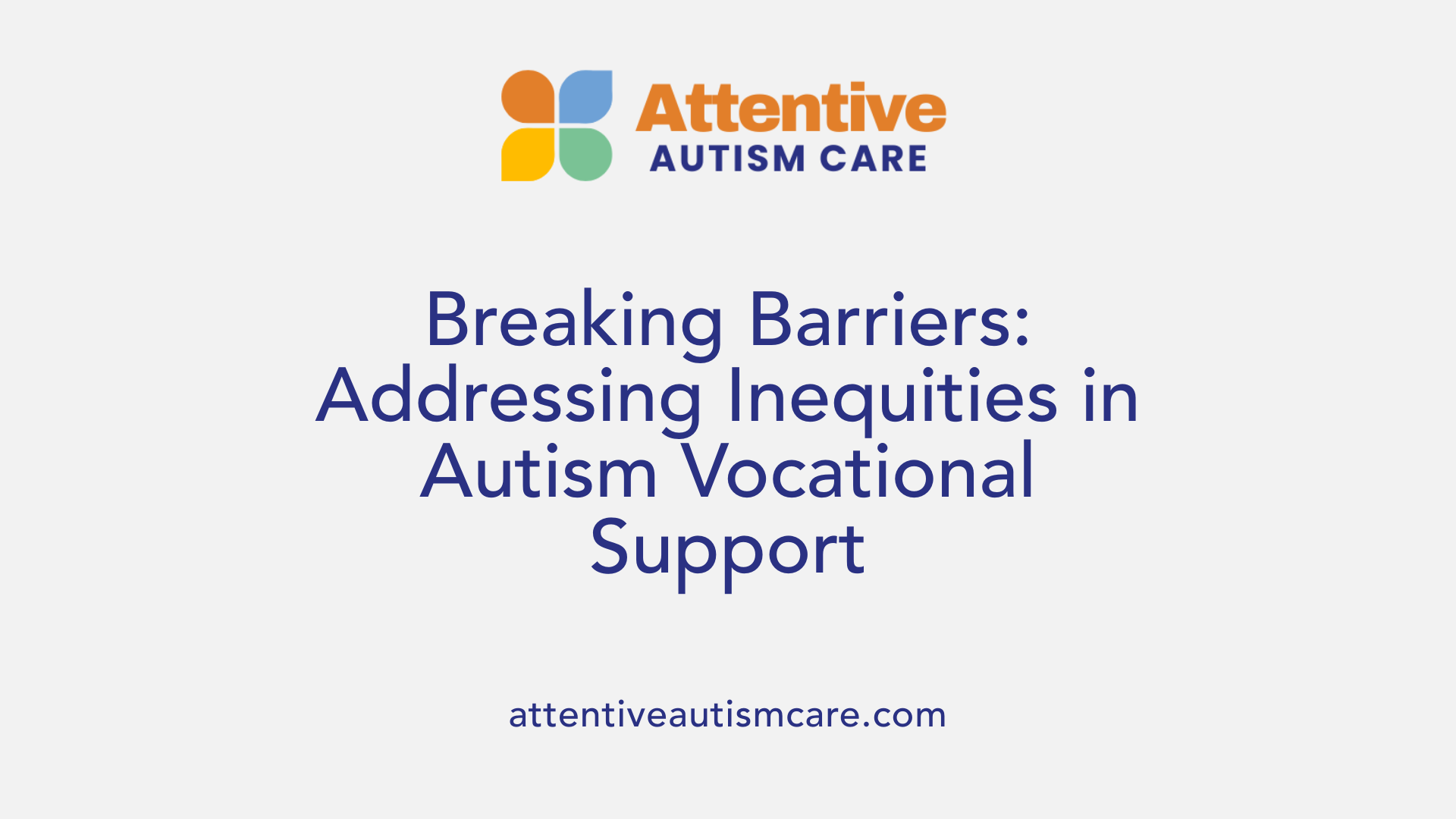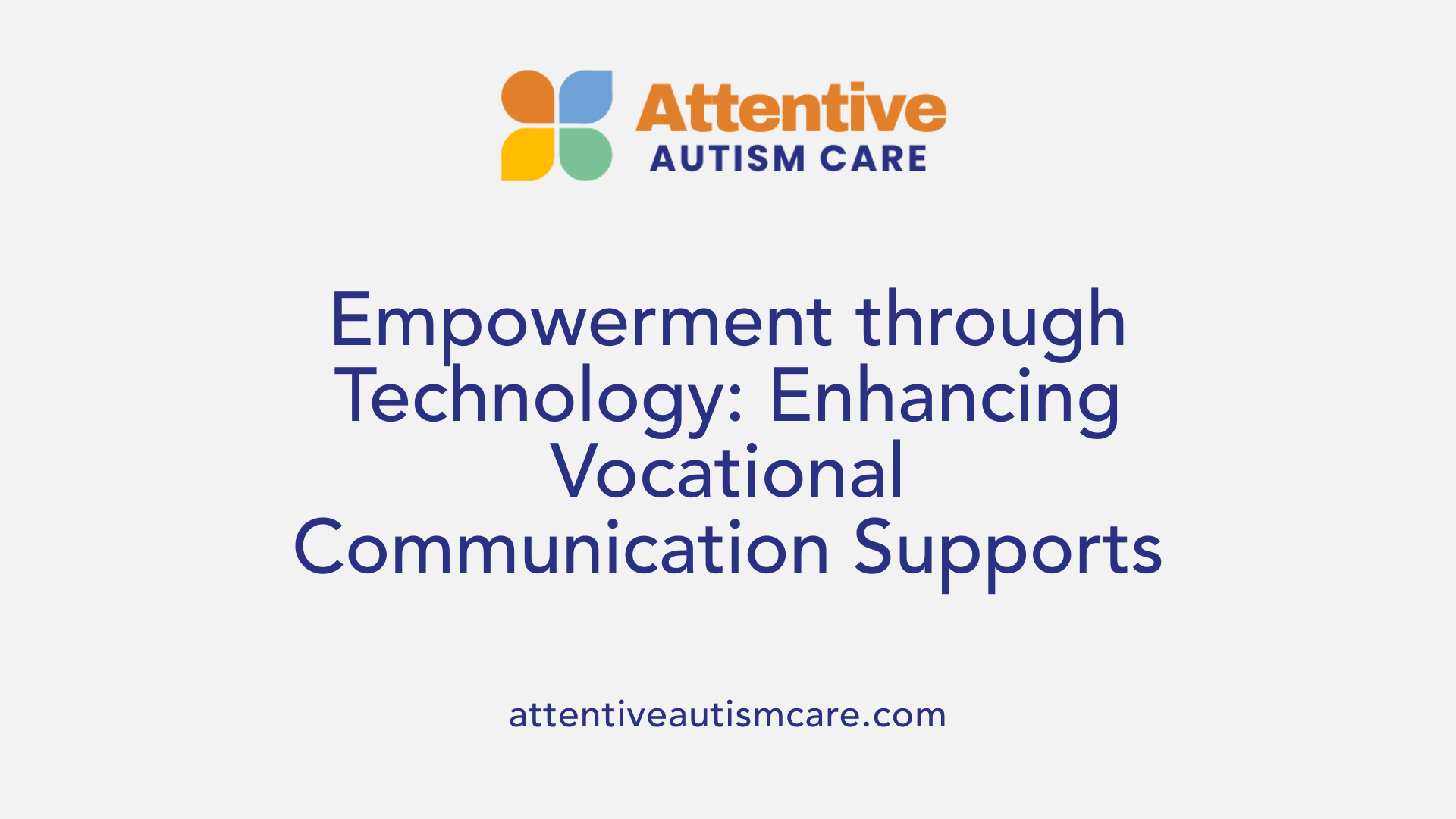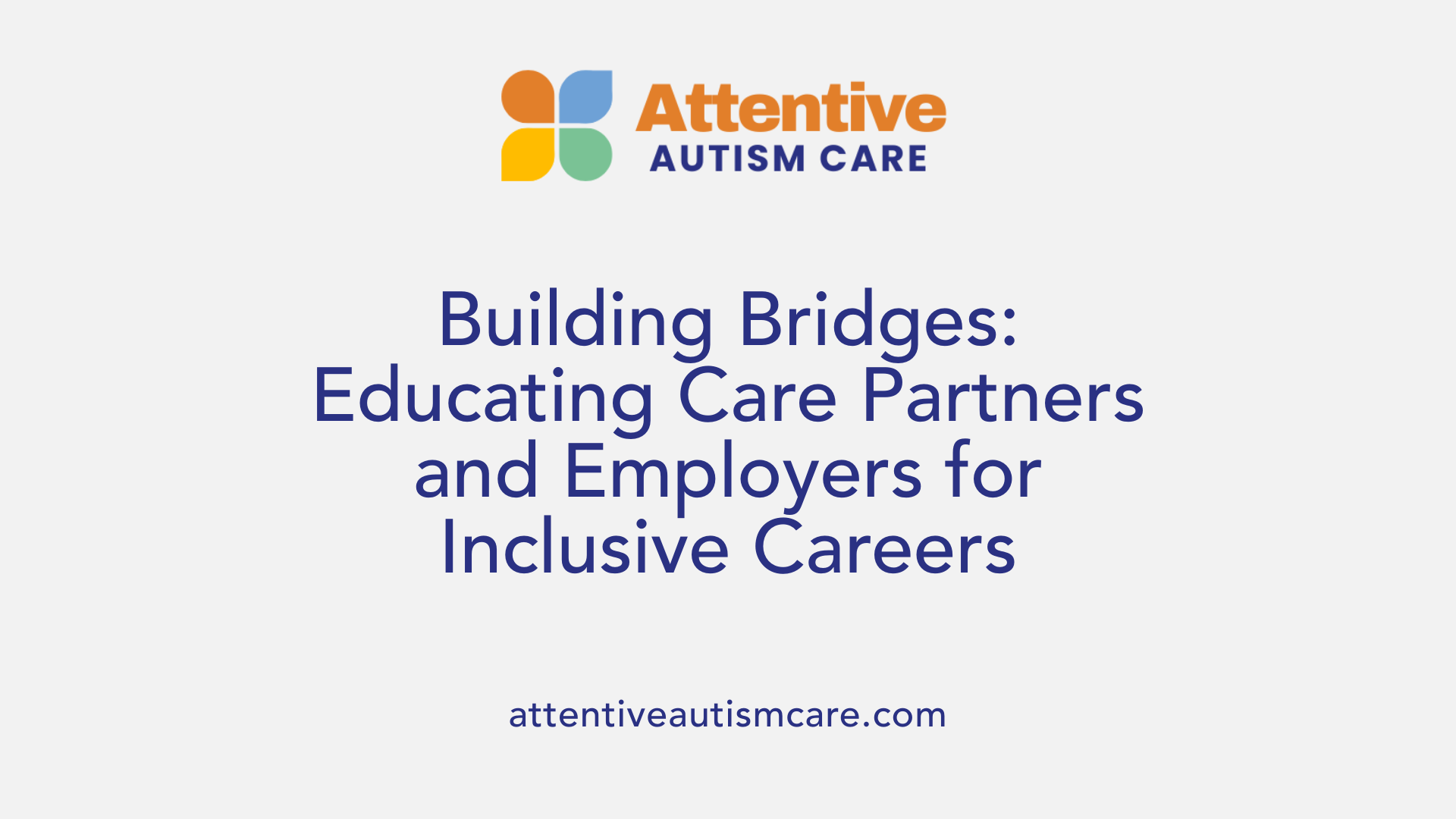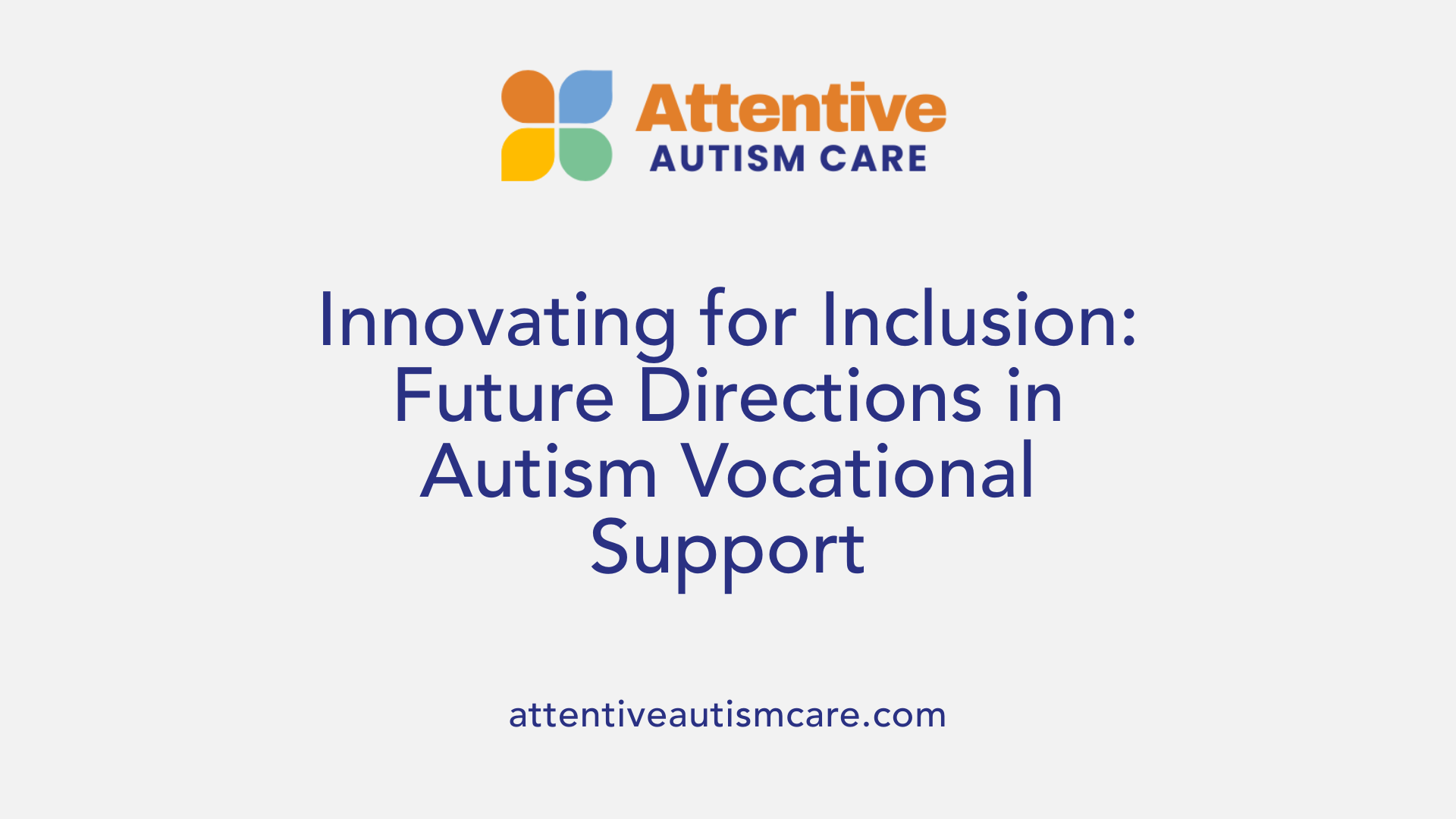Supporting Autistic Adults in Vocational Training
Enhancing Vocational Success for Autistic Adults: Evidence-Based Strategies and Support

Understanding Vocational Training Needs of Autistic Adults
Vocational training for autistic adults offers critical pathways to independence, skill development, and meaningful employment. Tailored interventions rooted in behavioral science and neurodiversity-affirming practices play vital roles in ensuring success in these programs. This article explores evidence-based frameworks, particularly Applied Behavior Analysis (ABA), alongside emerging considerations for person-centered supports that respect autistic identities and promote autonomy in vocational contexts.
The Role of Applied Behavior Analysis (ABA) in Supporting Vocational Skills
What is Applied Behavior Analysis (ABA) therapy and how does it help individuals with autism?
Applied Behavior Analysis (ABA) therapy is a science-based method rooted in learning theory, focusing on how behaviors are influenced by environmental factors. It aims to increase beneficial behaviors such as social interactions, communication, self-care, and academic skills, while decreasing behaviors that may interfere with learning or well-being. ABA employs structured techniques like positive reinforcement and assessments of antecedents, behaviors, and consequences to guide behavior change.
Qualified professionals called Board Certified Behavior Analysts (BCBAs) design individualized ABA programs tailored to each person's strengths and challenges. These programs often include data collection and continuous progress assessments to ensure effective goal attainment.
ABA interventions can occur in various settings such as homes, schools, and community environments. Early, intensive ABA therapy has demonstrated improvements in intellectual functioning, adaptive behaviors, and social skills, supporting greater independence.
Behavioral principles underlying ABA relevant to vocational skills
The foundation of ABA includes operant conditioning principles where behaviors are shaped by their consequences. Positive reinforcement encourages desirable actions, creating pathways for developing new skills necessary for vocational success. Understanding the antecedents and consequences surrounding workplace behaviors allows therapists to create strategies enhancing job-related competencies.
ABA also applies naturalistic strategies, embedding learning opportunities in meaningful contexts that mimic real-life job scenarios. These conditions support generalization of skills from therapy to actual vocational settings.
Use of ABA in skill acquisition relevant to vocational settings
ABA supports vocational skill development by targeting communication, social interaction, self-management, and routine tasks crucial for employment. Interventions may focus on:
- Enhancing workplace communication, including requesting assistance and following instructions.
- Teaching social skills such as collaboration, conflict resolution, and appropriate workplace behavior.
- Improving task sequencing, time management, and adherence to safety protocols.
- Promoting self-care and independence relevant to a work environment.
With ongoing assessment and client-centered planning, ABA helps tailor vocational goals aligning with individual preferences and strengths, respecting autonomy and promoting inclusion.
| Aspect | Details | Importance for Vocational Support |
|---|---|---|
| ABA Therapy Definition | Science-based behavior modification to increase functional skills | Foundation for structured vocational interventions |
| Behavioral Principles | Operant conditioning: reinforcement, antecedents, consequences | Tailored behavior change in workplace contexts |
| Skill Areas Targeted | Communication, social skills, task management, self-care | Essential competencies for employment success |
ABA remains a prominent approach to supporting autistic individuals in acquiring and maintaining vocational skills, emphasizing individualized, evidence-based strategies that foster independence and quality of life.
Professional Roles and Qualifications in ABA for Adult Vocational Training
Who provides ABA therapy and what qualifications do these professionals usually have?
Applied Behavior Analysis (ABA) therapy is delivered by skilled professionals with specialized training and certification. The primary providers include Board-Certified Behavior Analysts (BCBAs) and Registered Behavior Technicians (RBTs).
BCBAs are the lead experts who design and oversee ABA programs tailored to individual needs. They typically hold a master's or doctoral degree in psychology, behavior analysis, or a related field. Additionally, they must pass a rigorous certification exam and often obtain state licensure to practice. Their training equips them to conduct assessments, develop treatment goals, supervise staff, and adjust interventions based on data collected.
Registered Behavior Technicians (RBTs) work directly with clients delivering therapy sessions under BCBA supervision. RBTs complete specific training and pass a competency exam focused on implementing behavior analytic procedures and data collection.
Importance of family and caregiver involvement in adult programs
Family members and caregivers play a critical role in ABA services, including for autistic adults engaged in vocational training. Their involvement helps ensure skills learned during therapy generalize across environments like home, work, and community settings.
Caregiver education and coaching empower families to reinforce therapeutic goals and support autonomy. This collaboration supports a person-centered approach that respects individual preferences, fostering sustainable vocational skills and quality of life.
Common Techniques of ABA Applied to Vocational Training
What are the common techniques used in ABA therapy for autism?
Applied Behavior Analysis (ABA) utilizes several techniques tailored to improve functional skills and behaviors in autistic individuals, including those relevant to vocational training.
Discrete Trial Training (DTT)
DTT is a highly structured approach that breaks down skills into small, teachable components. In a typical DTT session, a trainer delivers an instruction (the "discrete trial"), prompts the correct response, and immediately provides reinforcement. This repetitive format is excellent for teaching specific vocational tasks such as using equipment, following safety protocols, or learning job-related routines.
Natural Environment Teaching (NET)
NET integrates teaching within natural settings, making skill acquisition more relevant and generalizable. For vocational purposes, skills like customer interaction, task initiation, or workplace communication can be practiced in real or simulated work environments. This method supports learning in context, enhancing transfer to actual job sites.
Pivotal Response Training (PRT)
PRT emphasizes motivation and self-initiation, targeting pivotal areas such as responsive communication and social interaction. By increasing an individual’s motivation to engage with tasks and coworkers, PRT helps improve participation and social competence in workplace roles.
Visual Supports and Behavior Chaining
Visual supports including picture exchange communication systems (PECS), schedules, and step-by-step charts scaffold communication and task completion. Behavior chaining involves breaking complex vocational tasks into sequential steps, teaching each step in order, and linking them to form a complete skill — such as operating machinery or completing a multi-step assembly.
Overall, these ABA techniques promote not only skill acquisition but also autonomy and self-advocacy in vocational settings. By combining structured learning, natural context, motivation strategies, and visual aids, ABA enhances the effectiveness and accessibility of vocational training programs for autistic individuals.
Measuring Progress in ABA-Based Vocational Programs
Data collection methods
In ABA-based vocational programs, precise data collection is essential for tracking individual progress. Therapists use various methods including event recording to count occurrences of target behaviors, duration to measure how long behaviors last, and latency to record the response time after a cue. Additionally, ABC (Antecedent-Behavior-Consequence) data is collected to understand environmental influences on behaviors. Continuous data collection provides detailed information, while discontinuous sampling may be applied when full recording isn't feasible. These methods ensure a thorough understanding of behavioral changes over time.
Use of behavioral graphs
Behavioral graphs are integral tools for visualizing progress. They depict trends in target behaviors and skills, making it easier for therapists and caregivers to see improvements or plateaus at a glance. Graphs provide concrete evidence of change and are critical for decision-making regarding ongoing interventions. They can display daily, weekly, or monthly progress, allowing for timely adjustments in treatment.
Role of parental/caregiver feedback
Parental and caregiver insights complement objective data by providing context about the individual’s functioning in real-life settings. Feedback often highlights subtle improvements or challenges that numbers alone may miss, such as changes in social interactions or independence during vocational tasks. Engaging caregivers ensures therapy goals align with the individual's everyday needs and supports generalization of skills beyond clinical environments.
Adjusting treatment plans based on data
Regular analysis of collected data allows behavior analysts to tailor interventions dynamically. When graphs and assessments indicate slow progress or emerging difficulties, treatment plans are revised to incorporate new strategies or modify goals. This data-driven approach ensures that vocational training remains effective and responsive to each autistic individual's unique development trajectory and personal preferences.
Addressing Misconceptions: Modern ABA’s Ethical and Person-Centered Approach
Common misconceptions about ABA therapy
Many people mistakenly view Applied Behavior Analysis (ABA) as a rigid or punitive approach focused only on suppressing autistic behaviors. Historically, some practices were controversial, but today's ABA has evolved significantly. Modern ABA emphasizes individualized, compassionate care that respects each person's unique needs, preferences, and identity.
Emphasis on positive reinforcement and client respect
Contemporary ABA practices prioritize positive reinforcement and building skills that enhance communication, social interaction, and everyday functioning. Programs are tailored by qualified Board Certified Behavior Analysts (BCBAs) who continuously monitor progress, ensuring therapy aligns with client values. Importantly, ethical ABA centers clients' autonomy, seeks to minimize harm, and incorporates trauma-informed methods.
ABA’s recognition by professional bodies
ABA is recognized as an evidence-based best practice by authoritative organizations including the U.S. Surgeon General and the American Psychological Association. Research involving over 20 studies demonstrates its effectiveness in improving intellectual functioning, language, social skills, and daily living abilities. It is considered the most extensively utilized behavioral intervention for autism spectrum disorder (ASD).
Focus on quality of life improvement
Rather than aiming to "cure" autism or enforce compliance, modern ABA seeks to enhance quality of life. This involves supporting skills needed for independence, communication, and meaningful social participation. The approach respects neurodiversity, working alongside autistic perspectives to foster acceptance and self-advocacy.
| Aspect | Misconception | Modern ABA Reality |
|---|---|---|
| Approach | Punitive and suppressive | Positive reinforcement with respect for individuality |
| Therapy Goals | Erasing autistic identity | Supporting functional skills and quality of life |
| Professional Recognition | Questionable efficacy | Evidenced by US Surgeon General and APA endorsements |
| Client Involvement | Minimal input | Client values and preferences central to intervention planning |
| Ethical Considerations | Overlooks trauma and assent | Trauma-informed care with client assent prioritized |
Neurodiversity Paradigm and Vocational Training: Shaping Supportive Practices
What is the Concept of Neurodiversity?
The neurodiversity paradigm views autism as a natural and valuable neurological variation rather than a disorder to be cured. It shifts focus from deficits to differences, encouraging acceptance and appreciation of autistic identities. This framework recognizes that neurological differences contribute to the diversity of human experiences and supports a social model of disability, which emphasizes societal and cultural factors over individual impairments.
How are Autistic Identities Respected in Vocational Settings?
Respecting autistic identities within vocational environments involves acknowledging individual strengths, interests, and unique perspectives. This respect manifests in neurodiversity-affirming practices that promote inclusivity and reduce stigma. Providing environmental adaptations, offering care partner education, and coaching are practical ways to create supportive workspaces that honor autistic individuals' needs and preferences.
How Are Goals Reoriented Toward Autonomy and Quality of Life?
Traditional vocational goals often emphasize normalization and compliance. In contrast, neurodiversity-affirming approaches prioritize an individual's autonomy, self-advocacy, and quality of life. This means shifting objectives away from erasing autistic behaviors towards supporting meaningful participation, personal fulfillment, and wellbeing in the workplace.
How is Neurodiversity Incorporated in Therapy and Training Models?
Occupational therapy and behavioral interventions are most effective when they incorporate strengths-based and trauma-informed approaches aligned with neurodiversity principles. Tailored programs—such as those involving coaching, assistive technology, and environmental adaptations—embrace autistic voices and individualized goals. This integration ensures therapies support vocational success without compromising identity or autonomy, fostering empowerment rather than conformity.
Incorporating Strengths, Interests, and Perspectives of Autistic Adults
Strengths-Based Language
Using strengths-based language is vital in occupational therapy to affirm and respect autistic adults. This approach shifts focus from deficits to capabilities, fostering a positive self-identity. Emphasizing abilities rather than limitations encourages engagement and reduces stigma.
Using Interests to Motivate Learning
Incorporating an individual’s unique interests can effectively motivate learning and skill development. Tailoring activities around these interests enhances participation and enjoyment, boosting both motivation and outcomes in therapy contexts.
Environmental Adaptations
Modifying physical and social environments supports autistic adults’ success in various settings. Adaptations such as reducing sensory overload, providing clear visual supports, and structuring spaces promote comfort and enable better focus and independence.
Care Partner Education and Coaching
Educating and coaching care partners equips them to better support autistic individuals. This includes understanding strengths, applying supportive strategies, and fostering autonomy. Collaborative coaching ensures interventions are consistent and respectful of the person’s preferences.
Together, these components form a neurodiversity-affirming approach that celebrates autistic identities and enhances occupational therapy service delivery across the lifespan.
Community-Engaged and Person-Centered Approaches in Vocational Programs
Importance of Involving Autistic Adults in Decision-Making
Incorporating the voices of autistic adults in vocational program design and implementation is crucial. Active involvement ensures programs reflect their lived experiences, preferences, and values. This participatory approach enhances relevance, ethical integrity, and effectiveness, fostering greater empowerment and ownership.
Community Engagement Benefits
Community engagement extends beyond individual involvement to include collaboration with stakeholders like families, employers, and service providers. This multi-layered partnership builds supportive networks that facilitate smoother transitions into employment and community life. Moreover, engagement boosts social inclusion and addresses systemic barriers related to ableism, inequities, and accessibility that impact vocational success.
Person-Centered Goal Setting
Person-centered planning tailors interventions to individual strengths, interests, and aspirations rather than enforcing external norms. By aligning vocational goals with personal priorities, programs optimize motivation and satisfaction. Documentation of client preferences and ongoing assessment allow for dynamic adaptations that respect autonomy and promote meaningful participation.
Promoting Self-Advocacy
Vocational programs must emphasize developing self-advocacy skills, empowering autistic adults to express needs, make informed decisions, and negotiate accommodations. Building confidence in self-advocacy supports autonomy and reduces reliance on others, critical for sustained employment and quality of life. Coaching and care partner education are effective strategies for nurturing these capabilities within neurodiversity-affirming frameworks.
Addressing Systemic Barriers and Inequities in Autism Vocational Services

Racial and Ethnic Inequities
Racial and ethnic disparities significantly affect access to autism diagnosis and subsequent vocational services. Marginalized groups often face delayed diagnoses due to systemic biases and lack of culturally responsive evaluations. This delay results in fewer early intervention opportunities that are crucial for positive developmental outcomes. Ensuring culturally competent assessment tools and outreach programs can help reduce these disparities.
Ableism in Vocational Settings
Ableism within vocational environments can hinder autistic individuals' participation, acceptance, and advancement. Stereotypes and misconceptions about autism may lead to exclusion or unfair expectations. To combat ableism, workplaces must adopt neurodiversity-affirming mindsets that appreciate autistic strengths and adapt job roles and environments accordingly.
Language and Diagnosis Accessibility
Language barriers limit many autistic individuals’ access to timely and accurate diagnoses. Non-English speakers or those from linguistically diverse backgrounds may experience challenges during clinical evaluations, leading to misdiagnosis or underdiagnosis. Incorporating multilingual resources and professional interpreters during assessment and service delivery ensures better inclusivity.
Strategies for Inclusion and Equity
Implementing person-centered, community-engaged approaches is essential to promote equity in vocational services. This includes:
- Employing multidisciplinary teams trained in culturally sensitive and trauma-informed care.
- Adapting services to respect individual preferences, strengths, and communication styles.
- Providing care partner education and coaching to support sustained participation.
- Investing in policy reforms that guarantee equitable insurance coverage and funding.
Such strategies improve access, foster acceptance, and support autistic individuals in achieving fulfilling vocational outcomes without eroding identity or autonomy.
Assistive Technology and Communication Supports in Vocational Training

Evaluation of Communication Devices
Communication devices play a vital role in supporting autistic individuals during vocational training by enhancing their ability to communicate effectively. Evaluating these devices involves assessing how well they meet the specific needs and preferences of the user. This evaluation must consider factors such as ease of use, adaptability to different environments, and their alignment with the individual's communication style.
Respecting Autonomy and Preferences
Central to successful assistive technology use is respecting the autonomy of autistic individuals. This means involving users in decisions about which devices and communication supports they use, ensuring that these tools empower rather than restrict their self-expression. Personal preferences should guide device selection and customization to support authentic communication and personal agency.
Avoiding Ableist Practices
When implementing assistive technologies, it is crucial to avoid practices that inadvertently perpetuate ableism. This includes steering clear of approaches that aim to "normalize" communication in ways that undermine autistic identity or require masking. Instead, supports should affirm neurodiversity, promote inclusion, and focus on enabling genuine interactions without pressuring conformity.
Examples of Augmentative and Alternative Communication (AAC)
AAC systems such as the Picture Exchange Communication System (PECS) are commonly used to facilitate communication initiation and requesting behaviors. While PECS has demonstrated improvements in communication initiation, its effects on speech development may be limited. Other AAC tools include speech-generating devices and sign language adaptations, all tailored to individual needs to maximize functional and meaningful communication during vocational activities.
Early Intensive Behavioral Interventions and Their Long-Term Impact
Why Is Early Intervention Critical for Autistic Individuals?
Early intervention during childhood is crucial for positively influencing developmental pathways and enhancing functional outcomes. When applied early, therapeutic approaches enable children to develop vital life skills during formative years, establishing foundations for greater independence and quality of life.
What is Early Intensive Behavioral Intervention (EIBI) and What Outcomes Does it Yield?
EIBI is a structured, intensive therapy rooted in applied behavior analysis (ABA), typically initiated before age 3 and delivered one-on-one over two to four years. Research indicates significant improvements in IQ and adaptive behaviors following EIBI, making it one of the most effective early treatments.
What Skills Does EIBI Help Develop?
The intervention comprehensively targets:
- Language acquisition and communication
- Cognitive abilities and problem-solving
- Social interaction and engagement
- Self-help and daily living skills
- Motor functions This broad skill development fosters holistic growth crucial for independence.
How Does Early Intervention Influence Adult Vocational Success?
Though research gaps remain, evidence suggests that gains from early intervention can extend into adulthood, supporting improved social functioning, communication, and daily skills—all vital for vocational engagement and success. Early foundations built through therapies like EIBI increase the likelihood of meaningful employment and community participation later in life.
Naturalistic Developmental Behavioral Interventions (NDBI) in Vocational Contexts
Combining developmental and behavioral approaches
Naturalistic Developmental Behavioral Interventions (NDBI) represent a hybrid approach that blends behavioral principles with developmental methods. This approach focuses on fostering social and communication skills in natural, everyday settings rather than structured clinical environments. By integrating both perspectives, NDBI enhances learning through meaningful interactions and natural reinforcement, which aligns well with the support of autistic individuals across contexts.
Early Start Denver Model (ESDM) overview
One of the well-known NDBI methods is the Early Start Denver Model (ESDM). Originally designed for young children, ESDM emphasizes engaging activities that promote language, imitation, social communication, and adaptive behaviors. Its flexible, play-based structure offers opportunities to practice skills in a natural context, supporting developmental progress while using behavioral strategies.
Improvements in social communication and adaptive behaviors
Research shows that NDBI and ESDM yield moderate to significant positive effects on language abilities, social communication, imitation, and daily adaptive functioning. These gains contribute to better integration within social settings, increased independence, and improved overall quality of life.
Application in adult vocational training
Although initially developed for early childhood, principles from NDBI are increasingly adapted for use in adult vocational training settings. This involves customizing interventions to enhance social communication, problem-solving, and adaptive skills directly relevant to workplace demands. Adults benefit from naturalistic coaching that respects their autonomy while improving practical work-related competencies.
This strengths-focused, context-based approach fits with neurodiversity-affirming and person-centered occupational therapy practices, offering meaningful support that adjusts to individual needs and preferences in vocational environments.
Parent-Mediated Interventions and Training for Vocational Support
Training Caregivers and Family
Parent-mediated intervention (PMI) involves equipping caregivers and family members with therapeutic techniques to support autistic individuals effectively. This training empowers parents to embed intervention strategies within daily routines, thereby boosting skill development in real-world contexts.
Enhancing Generalization of Skills
A major advantage of PMI is the improved generalization of skills across different environments. By involving caregivers directly, learned behaviors and vocational skills are more likely to be applied outside of clinical settings, enhancing long-term functional outcomes.
Parent-Implemented ESDM (P-ESDM)
The parent-implemented version of the Early Start Denver Model (P-ESDM) is a notable example of PMI. It has demonstrated effectiveness in improving parental interaction styles and social communication in young autistic children, setting a foundation for later vocational and social success.
Role in Lifelong Vocational Development
Training provided through PMI supports continuous skill acquisition and adaptation throughout life stages. By fostering early communication, social, and adaptive behaviors, these interventions facilitate smoother transitions into vocational environments and enable sustained participation in work-related activities.
This approach aligns with neurodiversity-affirming practices by valuing autistic individuals’ identities and emphasizing personalized, strength-based support within the family system.
Integrated Behavioral Interventions for Co-Occurring Challenges in Vocational Settings
Managing Sleep Disturbances
Sleep difficulties are common co-occurring challenges for autistic individuals, which can significantly impact their vocational readiness and stability. Behavioral interventions applied in these cases focus on increasing sleep duration and improving sleep quality. Techniques such as fading bedtime — gradually moving bedtime earlier — and scheduled awakening help establish healthier sleep patterns.
Addressing Eating Issues
Eating challenges frequently accompany autism and can affect daily functioning, including workplace performance. Behavioral strategies like contingent reinforcement, where positive outcomes follow desired eating behaviors, are used effectively to improve eating habits. These methods support better nutrition and mealtime routines important for maintaining energy and focus at work.
Behavioral Methods like Fading Bedtime and Contingent Reinforcement
Both fading bedtime and contingent reinforcement exemplify practical behavioral techniques tailored to individual needs. Fading bedtime modifies bedtime timing in small steps to ease the transition to an optimal sleep schedule. Contingent reinforcement systematically rewards target behaviors, encouraging positive changes such as improved eating and sleeping habits.
Impact on Vocational Readiness and Stability
By enhancing sleep and eating patterns, integrated behavioral interventions contribute to greater alertness, emotional regulation, and overall well-being, crucial for sustaining employment. Improved management of co-occurring conditions reduces absenteeism and supports consistent work performance, thereby fostering vocational independence and success for autistic adults.
Social Skills Training (SST) to Enhance Vocational Competence
Evidence-based SST models like JASPER
Social Skills Training (SST) programs such as JASPER (Joint Attention, Symbolic Play, Engagement, and Regulation) utilize evidence-supported techniques to enhance social competence, particularly focusing on key developmental areas like joint attention and play skills. These foundations are critical in early social development and form a basis for more complex interactions.
Targeting joint attention and play skills
JASPER and similar SST models work by improving the ability to share focus with others (joint attention) and engage in symbolic play, which helps develop communication and social interaction skills. These targeted interventions promote engagement and reciprocity, essential skills for building relationships and navigating social settings.
Outcomes for social responsiveness
Meta-analyses evaluating SST programs have revealed medium to large effect sizes in improving social responsiveness and social skills. Participants demonstrate enhanced ability to understand social cues, initiate interactions, and maintain appropriate social behaviors, which positively impact personal and community engagement.
Relevance to workplace social interaction
For autistic adults entering or already in the workforce, strong social skills are vital for collaboration, communication, and workplace integration. SST programs that address foundational social competencies can help improve vocational outcomes by preparing individuals to effectively interpret and respond to social dynamics in professional environments. This empowers autistic adults to build rapport with colleagues, navigate social norms, and enhance overall job performance.
Toilet Training and Self-Care: Foundational for Vocational Independence
What behavioral techniques support self-care skills in autistic individuals?
Effective behavioral techniques play a crucial role in developing self-care skills such as toileting among autistic individuals. Methods like shaping, graduated guidance, scheduled toileting, and stimulus control have been demonstrated as successful strategies to promote independence in these activities. These approaches focus on breaking down the skills into manageable steps, providing consistent cues, and reinforcing progress to foster autonomy.
How does rapid toilet training (RTT) utilize positive reinforcement?
Rapid Toilet Training (RTT) employs positive reinforcement and scheduled toileting to accelerate the acquisition of toileting skills, particularly benefiting children with intellectual disabilities. By systematically rewarding appropriate toileting behaviors and creating a structured routine, RTT helps reduce accidents and encourages self-sufficiency more quickly than traditional methods. This approach emphasizes the individual's motivation and adapts to their pace, increasing the likelihood of success.
Why are these self-care skills important for adult vocational readiness?
Toilet training and broader self-care competencies are foundational for adult vocational independence. Mastery of these skills reduces reliance on caregivers and supports participation in workplace activities that require personal care autonomy. By developing proficiency in self-care through behavioral interventions, autistic adults can enhance their confidence, social participation, and functional engagement in vocational settings, thereby improving overall quality of life.
Cognitive-Behavioral Therapy (CBT) for Emotional Regulation in Vocational Contexts
How is CBT used for depression, anxiety, and anger in autistic individuals?
Cognitive-Behavioral Therapy (CBT) is recognized as the most effective treatment for addressing emotional challenges such as depression, anxiety, and anger, particularly in adolescents and adults on the autism spectrum. CBT helps individuals identify and modify negative thought patterns and behaviors, leading to better emotional regulation and coping strategies.
What verbal and cognitive abilities are required for suitability in CBT?
CBT effectiveness depends on the individual's verbal, cognitive, and emotional capacities. The therapy requires a sufficient level of communication skills and cognitive understanding to engage in structured conversations about feelings, thoughts, and behaviors. Therefore, it is best suited for autistic individuals who possess adequate verbal abilities and cognitive skills to actively participate in the process.
How does CBT benefit emotional challenges in workplace settings?
In vocational contexts, CBT supports autistic adults by enhancing their ability to recognize and manage stressors related to depression, anxiety, and anger that may arise in the workplace. Improved emotional regulation through CBT can lead to better job performance, reduced workplace conflicts, and improved interpersonal interactions, thereby fostering a more positive work environment and greater occupational success.
How is CBT integrated with other vocational supports?
CBT is often combined with other vocational supports such as occupational therapy, social skills training, and coaching to provide a comprehensive framework tailored to individual needs. This multidisciplinary approach ensures that emotional regulation strategies are reinforced alongside skills development and environmental adaptations, creating a holistic support system for autistic individuals navigating vocational challenges.
Behavioral Assessments Informed by Client Perspectives
Understanding behavior functions beyond traditional models
Traditional behavioral assessments often categorize behaviors using the four classical functions—attention, escape, access to tangibles, and sensory stimulation. However, more comprehensive evaluations recognize that behaviors can serve complex purposes, including emotional expression and physiological needs. This broader perspective allows clinicians to better understand the underlying causes of behaviors beyond surface-level manifestations.
Incorporation of emotional and physiological states
Effective assessment includes considering how emotional states like anxiety, frustration, or excitement, as well as physiological factors such as pain or sensory sensitivities, influence behavior. Acknowledging these internal experiences helps tailor interventions that address the root causes rather than merely managing symptoms.
Engaging client’s voice in assessments
Centering the individual's perspective is crucial. Engaging autistic individuals in their own behavioral assessments respects their autonomy and provides insights into how their behaviors relate to their experiences. This approach improves accuracy and ensures that interventions align with their values and preferences.
Implications for vocational interventions
In vocational training and support, understanding behavior through this enriched lens facilitates the creation of supportive environments that accommodate emotional and sensory needs. Behavioral strategies grounded in personal insight promote sustainable participation in work settings and enhance job satisfaction.
By expanding behavioral assessments to include emotional, physiological, and client-driven factors, interventions become more person-centered and effective, especially in vocational contexts where social, sensory, and emotional demands are significant.
Trauma-Informed Care Principles in Vocational Support for Autistic Adults
Recognizing trauma and its impact
Understanding that autistic adults may experience trauma related to systemic barriers, ableism, and marginalization is essential. Trauma can profoundly affect emotional regulation, social interactions, and engagement in work environments, necessitating sensitive vocational support.
Adapting interventions to avoid retraumatization
Vocational interventions should be carefully tailored to individual needs to prevent retraumatization. This includes using strengths-based language and environmental adaptations that respect personal boundaries and preferences. Emphasizing coaching and care partner education fosters a supportive and non-coercive atmosphere.
Emphasizing safety and trust
Creating a vocational setting that promotes psychological safety and trust is vital. Providers should build relationships grounded in respect, transparency, and client autonomy, actively involving autistic adults in decision-making processes related to their career goals and intervention strategies.
Aligning with neurodiversity-affirming principles
Embedding neurodiversity-affirming practices reinforces respect for autistic identities and lived experiences. This means moving away from pathologizing behaviors and instead focusing on enhancing quality of life and functional outcomes, aligned with the individual's values and preferences. Listening to autistic voices in shaping vocational support ensures interventions remain relevant and empowering.
Challenges and Gaps in Research on Autistic Adults in Vocational Training
Limited data on marginalized populations
Research on autistic adults in vocational training settings reveals significant gaps, especially concerning marginalized groups. Studies often overlook the unique experiences of racial and ethnic minorities, non-English speakers, and those facing systemic barriers. This lack of representation hinders the development of culturally sensitive and equitable vocational interventions.
Participation in activities of daily living (ADLs)
Current research inadequately addresses how vocational training impacts the daily functioning of autistic adults in areas such as self-care, mobility, and independent living. Understanding these interconnections is crucial for designing programs that not only improve job skills but also support broader life participation.
Need for trauma-informed care studies
There is a pressing need for more trauma-informed approaches within vocational training research. Autistic adults may experience trauma linked to stigmatization, ableism, and previous negative interventions. Incorporating trauma-informed care principles can lead to safer, more supportive environments that respect autistic identities and foster resilience.
Research priorities for adult-focused interventions
Future research should prioritize person-centered, neurodiversity-affirming frameworks tailored to adult needs. This includes evaluating the effectiveness of coaching, environmental adaptations, and assistive technologies that enhance autonomy. Additionally, investigation into long-term outcomes of interventions on employment success and quality of life remains limited and requires expansion to guide best practices.
Addressing Historical Critiques of ABA in Adult Services
Acknowledging ABA’s Controversial History
Applied Behavior Analysis (ABA) has faced significant criticism, particularly from the autistic community, for its historical roots that include associations with conversion therapy. This history has contributed to concerns about practices that may prioritize compliance over individual well-being.
Criticism Regarding Compliance Focus and Identity Erasure
One of the main critiques of traditional ABA is its emphasis on reducing autistic behaviors that some perceive as attempts to erase autistic identity. Such practices can lead to negative outcomes like masking, burnout, and trauma, especially in adult services where autonomy and identity are paramount.
Reforming Practices to Center Autistic Voices
Modern approaches call for a shift toward neurodiversity-affirming and trauma-informed ABA practices. This includes actively involving autistic individuals in treatment decisions, respecting their perspectives, and tailoring interventions to support strengths and preferences rather than enforce conformity.
Promoting Self-Advocacy and Client Assent
Enhancing adult ABA services involves ensuring informed consent and client assent foundational to ethical care. Supporting self-advocacy empowers autistic adults to guide their own goals and interventions, fostering autonomy and quality of life above mere behavioral compliance.
Social Model of Disability and Vocational Inclusion
Disability as a Social and Political Construct
The social model of disability challenges traditional views by defining disability not as an inherent flaw within an individual but as a result of societal, cultural, and political barriers. This perspective shifts focus from personal limitations to the need for societal change to support inclusion.
Removing Environmental Barriers
Removing environmental barriers is central to fostering vocational inclusion for autistic adults. These barriers can include physical obstacles, inaccessible communication methods, and rigid workplace policies. Modifying workplace environments and practices increases accessibility and autonomy for people on the autism spectrum.
Promoting Civil Rights and Inclusion
Emphasizing civil rights, the social model advocates for equal opportunities and protection against discrimination. It encourages legal frameworks and social policies ensuring autistic individuals are valued and included in all aspects of community and work life.
Application to Workplace Accommodations
In practice, the social model supports implementing accommodations tailored to individual needs, such as flexible schedules, sensory-friendly workstations, and communication supports. This approach aligns with neurodiversity-affirming principles, enhancing participation and job satisfaction for autistic employees.
Using Strengths-Based Language to Enhance Training Outcomes
Shift from Deficit-Focused to Strength-Focused Communication
Moving from a deficit-focused to a strengths-based communication approach is essential in autism-related training and therapy. Instead of highlighting limitations or challenges, this approach emphasizes the unique abilities, interests, and perspectives of autistic individuals. This shift aligns with neurodiversity-affirming practices that respect and celebrate neurological differences as natural variations.
Impact on Motivation and Self-Esteem
Adopting strengths-based language can significantly boost motivation and self-esteem in autistic individuals. Recognizing and verbalizing their capabilities helps build confidence, encourages engagement, and supports positive identity development. This empowerment forms a critical foundation for successful learning and skill acquisition.
Encouraging Functional Independence
By focusing on strengths in communication and coaching, occupational therapy interventions can better promote functional independence. When individuals understand and leverage their abilities, they are more likely to participate actively in daily living activities, decision-making, and self-advocacy, which enhances quality of life.
Incorporation in Coaching and Occupational Therapy
Occupational therapy practitioners and coaches are encouraged to integrate strengths-based language throughout their work. This includes environmental adaptations, education of care partners, and client-centered coaching strategies that emphasize personal growth rather than correction. Such language frameworks foster trauma-informed care, reduce ableism, and ensure therapy services are respectful and affirming of autistic identities.
Environmental Adaptations to Support Autistic Adults in Workplaces
Modifying Sensory Environment
Workplaces can enhance comfort and productivity for autistic adults by modifying sensory aspects such as lighting, noise levels, and odors. This may include providing noise-cancelling headphones, using natural lighting or adjustable light sources, and creating quiet spaces free from overwhelming sensory input.
Adjusting Workflows and Schedules
Flexible scheduling and structured workflows assist in accommodating the unique needs of autistic employees. Allowing for breaks when sensory overload occurs and providing clear timelines helps reduce stress and improves focus. Job tasks can also be tailored to align with individual strengths and preferences.
Providing Clear Visual Supports
Visual aids like schedules, checklists, and step-by-step guides support understanding and task completion. Clear signage and visual cues reduce ambiguity and promote independence in workplace tasks.
Examples of Successful Adaptations
Some organizations have implemented ‘‘quiet zones’’ and personalized workstations to minimize distractions. Companies using visual planning tools alongside flexible work hours have reported improved employee engagement and productivity among autistic staff. These adaptations reflect a neurodiversity-affirming approach that centers on strengths and preferences, fostering an inclusive work culture.
Educating Care Partners and Employers for Inclusive Vocational Settings

Training on Neurodiversity and Autism
Educating care partners and employers begins with comprehensive training about neurodiversity and autism. This training should highlight autism as a natural neurological variation, emphasizing the strengths and perspectives of autistic individuals rather than focusing solely on deficits. By understanding neurodiversity, employers and caregivers can foster environments that respect autistic identities and embrace inclusive practices.
Promoting Understanding and Acceptance
Promoting genuine understanding and acceptance helps to reduce ableism and dismantle systemic barriers faced by autistic individuals in vocational settings. Educational programs should incorporate trauma-informed approaches and incorporate language that is strengths-based to improve how autistic employees and clients are perceived and supported. This approach encourages respect for personal preferences, autonomy, and lived experiences.
Supporting Coaching Strategies
Care partners and employers benefit significantly from coaching on practical support strategies tailored to individual needs. Coaching may include guidance on environmental adaptations, communication techniques, and behavior support, all aligned with the client’s values and preferences. These collaborative efforts help translate theoretical knowledge into daily practices that enhance autonomy and quality of life.
Building Sustainable Support Networks
Sustainable support relies on building strong, ongoing networks among care partners, vocational staff, and the autistic individuals themselves. These networks provide continuous education, peer support, and resource sharing that are vital to maintaining inclusive workplaces. Inclusion of autistic voices in governance and decision-making processes strengthens these networks by ensuring that interventions and policies remain relevant and respectful.
Together, these educational efforts empower care partners and employers to create inclusive vocational environments that maximize strengths, respect diversity, and support all individuals' participation and success.
Person-Centered Documentation and Goal Adaptation
Documenting Client Preferences
Thoroughly recording the preferences, values, and lived experiences of autistic individuals is crucial in tailoring interventions that respect and support their unique identities. Clinicians are encouraged to gather detailed input from clients, ensuring that therapeutic goals align with their personal aspirations and comfort levels. This documentation forms the foundation for truly individualized care.
Adapting Interventions to Individual Needs
Each autistic person presents a distinct profile of strengths, challenges, and contexts. Interventions must therefore be carefully adapted to reflect these individual characteristics alongside the environmental setting. This ensures that therapeutic strategies are meaningful, effective, and supportive of autonomous engagement.
Balancing Goals and Values
While goal-oriented therapy remains important, it needs to balance functional outcomes with respect for the individual's values and neurodiversity. Sensitivity to client perspectives mitigates the risk of pursuing goals that might reinforce masking, burnout, or trauma and instead fosters growth consistent with the person’s self-identified priorities.
Ensuring Flexibility in Vocational Programming
Vocational programs supporting autistic individuals should incorporate flexible objectives that can evolve over time. By allowing for adjustments based on ongoing assessment and client feedback, programs become more responsive and empowering, promoting sustainable success and quality of life.
| Aspect | Description | Practical Application |
|---|---|---|
| Client Preferences Documentation | Systematic recording of preferences and values | Use questionnaires and interviews to capture goals and comfort levels |
| Individual Needs Adaptation | Tailoring interventions to unique profiles | Modify techniques in occupational therapy or ABA based on sensory, communicative, and emotional needs |
| Goal-Value Balance | Aligning therapy aims with personal values | Prioritize goals that enhance autonomy and well-being, not just symptom reduction |
| Vocational Flexibility | Creating adaptable work-focused programs | Allow for iterative goal revision and include client decision-making in career planning |
Insurance Coverage and Funding Challenges for Adult Vocational ABA Services
What roles do Medicaid and private insurance play in funding ABA services?
Medicaid typically covers ABA therapy for children diagnosed with autism when prescribed as medically necessary. Some private insurance plans also provide coverage, though this varies widely. However, for adult vocational ABA services, coverage is much less consistent across both Medicaid and private insurers.
How variable is coverage for adult ABA services?
Coverage for ABA in adults often differs significantly by state and provider. Many insurance programs focus on early childhood interventions, so adult vocational ABA services may be excluded or considered non-essential benefits. This variability creates a patchwork system where some adults receive substantial support while others face financial barriers or complete lack of coverage.
Why is advocacy for broader funding important?
Broader funding advocacy aims to bridge gaps in coverage and ensure adults can access vocational ABA therapies that improve functional and employment outcomes. Given that autism support needs persist throughout the lifespan, expanding insurance coverage beyond childhood is crucial for equity.
What implications arise for access and equity?
Inconsistent insurance coverage for adult services disproportionately affects marginalized groups facing systemic barriers, compounding disparities in diagnosis, treatment access, and outcomes. Without equitable funding, many adults with autism may miss vital vocational supports that promote independence and quality of life.
Overall, addressing insurance and funding challenges is critical to making adult vocational ABA services accessible, affordable, and aligned with person-centered, neurodiversity-affirming care principles.
Collaborative Governance: Inclusion of Autistic Voices in Program Design
Why is it important to involve autistic adults in research and program design?
Involving autistic adults in research and program design ensures that interventions and services truly reflect their lived experiences and preferences. Including autistic voices improves the relevance, ethics, and effectiveness of programs by centering perspectives often overlooked in traditional models.
What decision-making roles can autistic individuals hold in organizations?
Autistic adults can serve on advisory boards, steering committees, and executive leadership roles within organizations to influence policies and program directions. Their participation in governance fosters accountability and alignment with community values.
How does collaborative governance improve ethics and relevance?
Collaborative governance promotes transparency, respects autonomy, and values neurodiversity. It moves away from paternalistic approaches by incorporating first-person insights, reducing ableism, and ensuring that interventions support quality of life rather than mere normalization.
What examples of collaborative models exist?
Community-engaged research frameworks involve autistic stakeholders throughout the research process, from question formulation to dissemination. Organizations adopting participatory decision-making invite continuous input from autistic clients, family members, and advocates to co-create services that are culturally and contextually sensitive.
By centering autistic voices in governance and program design, the field advances toward neurodiversity-affirming practices that honor identity and lived experience while improving service outcomes.
Reframing ABA Goals from Normalization to Quality of Life Support
Transition from behavior suppression to empowerment
Traditional ABA has centered on reducing behaviors viewed as undesirable, often aiming to normalize autistic individuals. However, current guidance suggests shifting focus toward empowering autistic people. This means valuing behaviors as meaningful expressions of identity and needs rather than simply targeting suppression.
Supporting autonomy in vocational choices
ABA goals now emphasize supporting autistic individuals’ autonomy, especially in vocational domains. Therapy aims to equip individuals with skills that foster independence, decision-making, and success in work environments aligned with their strengths and interests. This respects personal choice rather than enforcing compliance.
Fostering acceptance and self-advocacy
Aligning ABA with neurodiversity principles involves fostering autistic self-advocacy and acceptance. Interventions encourage individuals to understand and embrace their identities, providing tools to communicate needs effectively and engage in self-directed goal setting.
Alignment with neurodiversity principles
Reframing ABA involves integrating neurodiversity-affirming approaches that recognize autism as a natural variation rather than a deficit. Goals shift from normalization to enhancing quality of life, respecting client preferences, and reducing harm linked to masking or compliance pressures. Collaboration with autistic individuals ensures therapy is trauma-informed, person-centered, and supportive of lived experiences.
Data-Driven Adjustments in Adult Vocational Programs
Continuous Data Collection Importance
Ongoing data collection plays a crucial role in adult vocational programs for autistic individuals. It allows professionals to monitor progress meticulously, ensuring interventions remain effective over time. By systematically recording behaviors, skills acquisition, and challenges, programs can maintain a dynamic, responsive approach tailored to individual needs.
Evidence-Based Tweaking of Goals
Vocational goals should not remain static. Using evidence gathered through regular assessments, adjustments can be made to better align with each adult’s evolving capacities and aspirations. This practice facilitates growth in areas such as communication, social skills, and independent work strategies, which are essential for successful employment outcomes.
Responding to Client Feedback
Incorporating client perspectives is fundamental for shaping meaningful interventions. Adult participants provide invaluable insights regarding their preferences, strengths, and areas of concern. Such feedback ensures that programs support autonomy and respect neurodiversity, ultimately enhancing client engagement and satisfaction.
Documenting Successful Adaptations
Thorough documentation of changes and outcomes establishes an evidence base to guide best practices. Recording which adaptations have led to improved participation or skill development supports transparency and helps replicate success in similar vocational settings.
Overall, data-driven, person-centered adjustments enhance the effectiveness of adult vocational programs, honoring individual needs while promoting positive long-term functional results.
Building Resilience and Preventing Burnout in Autistic Adults Through Vocational Training
Recognizing Masking and Burnout Signs
Autistic adults often experience masking—concealing their autistic traits to fit social norms—which can lead to significant stress and burnout. Recognizing signs such as exhaustion, withdrawal, decreased productivity, and heightened anxiety is crucial in vocational settings. Awareness allows for timely interventions to support mental health and well-being.
Creating Supportive Environments
Supportive work environments are essential for resilience. This involves adapting the workplace to accommodate sensory and social needs, using strengths-based language, and fostering acceptance of neurodiversity. Including autistic perspectives in decision-making promotes respect for individual identities and fosters a sense of belonging.
Promoting Sustainable Work Habits
Training should focus on sustainable work habits that prevent fatigue. Strategies include realistic goal-setting, allowing flexible breaks, and teaching self-advocacy skills. Empowering autistic adults to pace their work and communicate their needs reduces the risk of burnout and supports long-term vocational success.
Integrating Trauma-Informed Care
Integrating trauma-informed care recognizes past experiences and minimizes re-traumatization. This approach emphasizes safety, trust, and collaboration between vocational trainers and autistic adults, ensuring interventions respect individual values and foster autonomy.
These elements combined create vocational training programs that not only enhance skill development but also build resilience and prevent burnout in autistic adults, leading to more fulfilling and sustainable employment outcomes.
Using Social Skills Training to Navigate Workplace Relationships
Developing communication strategies
Social skills training (SST) empowers autistic adults by equipping them with practical communication strategies tailored to workplace settings. These strategies focus on enhancing clarity, understanding social cues, and managing conversations effectively.
Role-playing and real-world practice
Role-playing scenarios within SST create safe environments to rehearse workplace interactions. This hands-on practice allows individuals to experience diverse social situations and receive constructive feedback, thereby facilitating smoother integration in actual work contexts.
Building confidence in social interactions
Consistent SST participation fosters increased self-confidence by gradually reducing social anxiety and improving expressive abilities. As individuals gain mastery over social nuances, their ability to engage comfortably with colleagues strengthens.
Long-term social competence benefits
SST contributes to sustained improvements in social responsiveness and interpersonal relationships. Enhanced social competence directly supports job retention, career advancement, and overall workplace satisfaction for autistic adults.
Social skills training, especially models backed by research such as JASPER, demonstrates medium to large effect sizes in improving social functioning. By focusing on meaningful communication and interactive skills development, SST facilitates positive workplace relationships and promotes a supportive professional environment for autistic individuals.
Augmentative and Alternative Communication (AAC) to Enhance Vocational Autonomy
How Effective Are PECS and Other AAC Systems?
Augmentative and Alternative Communication (AAC) systems, including the Picture Exchange Communication System (PECS), have demonstrated effectiveness in helping autistic individuals express their needs and initiate communication. Evidence highlights improvements in initiating requests and conversations, which are critical skills for vocational settings.
How Do AAC Systems Support Request Initiation and Conversation?
AAC tools enable users to communicate desires and engage in social interactions by substituting or supplementing traditional speech. This support can improve workplace participation, allowing autistic adults to more confidently navigate tasks and collaborate with colleagues.
Why Is It Important to Respect Individual Communication Preferences?
Selecting AAC approaches must honor personal autonomy and preferences to avoid ableist practices. Tailoring communication methods to the individual's unique strengths and interests ensures interventions affirm neurodiversity and enhance efficacy.
What Are the Limitations and Strategies to Maximize Benefit?
While AAC systems support communication initiation, some limitations exist, such as mixed effects on speech development. To maximize benefits, integrating AAC with personalized coaching and environmental adaptations can facilitate broader social engagement and vocational skill building.
| Aspect | Description | Vocational Impact |
|---|---|---|
| PECS and AAC Effectiveness | Improves request initiation and conversation | Facilitates task requests and collaboration |
| Individual Preferences | Aligning AAC type and usage with the user's strengths and choices | Increases acceptance and sustained use |
| Limitations | Possible limited effect on speech, requiring complementary strategies | Necessitates additional supports for complex communication |
| Maximizing Benefits | Combined coaching, environmental adaptations, and strength-based approaches | Enhances autonomy, job performance, and social inclusion |
Collaboration Among Therapists, Employers, and Support Networks
Coordinating Across Disciplines
Effective support for autistic individuals in vocational settings relies heavily on collaboration among occupational therapists, behavior analysts, speech therapists, employers, and support networks. Multidisciplinary, goal-oriented interventions provided throughout the lifespan ensure that therapies are comprehensive and address the unique needs of the individual. This approach helps align therapeutic goals with workplace expectations and personal strengths.
Sharing Data and Progress
Systematic data collection and ongoing assessment—hallmarks of practices like Applied Behavior Analysis (ABA)—play a crucial role in updating all stakeholders on an individual's progress. Transparent sharing of such data fosters consistency across home, therapy, and work environments, enabling informed decision-making and tailored support adjustments.
Training Employers and Coworkers
To create supportive workplaces, educating employers and coworkers on neurodiversity, disability rights, and trauma-informed care is essential. Training should include understanding autism from a neurodiversity-affirming perspective, emphasizing communication preferences, accommodations, and respectful language use. This education promotes empathy and reduces ableism and systemic barriers.
Creating Inclusive Work Culture
An inclusive workplace values the strengths and perspectives of autistic employees, encouraging autonomy and participation. Adjustments such as environmental modifications and coaching can facilitate success. Cultivating acceptance rather than conformity aligns with the neurodiversity paradigm, supporting quality of life and meaningful employment experiences.
Interdisciplinary collaboration not only enhances therapy outcomes but also improves workplace inclusion and fosters positive relationships among all parties involved.
Linking Occupational Therapy Practices with ABA in Vocational Training
How does neurodiversity-affirming occupational therapy enhance vocational training?
Neurodiversity-affirming occupational therapy recognizes autism as a natural neurological variation rather than a disorder to be "fixed." This perspective highlights respecting autistic identities and prioritizing quality of life over normalization. In vocational training, this approach encourages personalized goal-setting that centers on the individual's strengths, preferences, and long-term aspirations, fostering a more empowering and supportive learning environment.
How are strengths and perspectives incorporated in occupational therapy?
Occupational therapy (OT) integrates autistic individuals’ unique strengths and interests to tailor interventions that resonate deeply with them. By actively involving clients in decision-making and valuing their lived experiences, occupational therapists promote more engaging and meaningful skill development. Acknowledging these perspectives ensures that vocational goals align with personal values, improving motivation and success in job-related tasks.
What environmental adaptations and coaching methods support effective vocational training?
OT practitioners utilize environmental modifications—such as sensory-friendly workspaces and clear organizational systems—to reduce barriers and improve accessibility. Additionally, coaching of care partners and employers equips them with strategies to support autistic employees effectively. Using strengths-based language and trauma-informed practices further encourages positive workplace experiences and reduces stress, enabling better job performance and satisfaction.
How do occupational therapy and Applied Behavior Analysis (ABA) complement each other?
While occupational therapy focuses on holistic skill development, including motor, sensory, and daily living skills, ABA uses structured, evidence-based behavior modification to enhance communication, social skills, and adaptive behaviors critical to employment success. Collaborative approaches enable the integration of goal-oriented ABA techniques—such as positive reinforcement and functional behavior assessments—with OT’s personalized environmental and coaching strategies. This synergy facilitates comprehensive support tailored to the autistic individual's vocational needs and autonomy.
| Aspect | Occupational Therapy (OT) | Applied Behavior Analysis (ABA) | Complementary Role |
|---|---|---|---|
| Focus | Holistic skill development, environmental adaptations | Behavior assessment and modification | OT addresses environmental and functional needs; ABA targets behaviors impacting job performance |
| Client Role | Active participation, valuing client perspectives | Data-driven behavior goals formulated by qualified analyst | Integrates client preferences with behavioral objectives |
| Intervention Strategies | Coaching, care partner education, strengths-based language | Positive reinforcement, analysis of antecedents-behaviors-consequences (A-B-Cs) | Combining behavioral techniques with tailored environmental supports |
| Vocational Application | Developing adaptive, sensory, and daily living skills | Enhancing communication, social skills, and compliance | Jointly improve workplace competence and comfort |
Future Directions: Research and Innovation in Vocational Support for Autistic Adults

Filling research gaps for marginalized populations
Despite growing understanding of autism, significant gaps remain in research focusing on marginalized groups among autistic adults. This includes racially and ethnically diverse populations, where systemic barriers and inequities limit access to diagnosis and services. Future studies must prioritize inclusive methodologies that account for these disparities, ensuring vocational supports are culturally sensitive and equitable.
Expanding trauma-informed vocational studies
Trauma-informed care has been identified as crucial across autism interventions, yet vocational settings for autistic adults lack comprehensive research. Innovations in this area should explore how trauma may impact employment experiences and how workplaces can adapt to maintain psychological safety. Emphasizing neurodiversity-affirming and person-centered approaches can enhance emotional well-being and functional outcomes in vocational contexts.
Innovating technology and communication tools
Assistive technologies and communication strategies are vital to supporting autonomy and participation in vocational environments. Emerging research must assess new and existing tools not only for effectiveness but also for alignment with autistic individuals’ preferences, to avoid ableist practices. Innovations in augmentative and alternative communication (AAC) and assistive devices tailored for workforce inclusion could transform employment experiences.
Policy and practice advancement for inclusive employment
Advancing policies that address systemic barriers, ableism, and inequities is essential for inclusive vocational support. Research should inform practices that integrate strengths-based language, environmental adaptations, and care partner education into employment services. Collaboration with the autistic community will ensure policies uphold autonomy, respect diversity, and support meaningful participation in the workforce.
| Focus Area | Description | Importance for Vocational Support |
|---|---|---|
| Marginalized Populations | Target inclusive research addressing diverse needs | Ensures equity and tailored supports |
| Trauma-Informed Studies | Examine psychological safety and trauma impact at work | Enhances emotional health and job retention |
| Technology & Communication | Assess and innovate AAC and assistive devices | Fosters autonomy and effective workplace engagement |
| Policy & Practice | Develop inclusive policies and community partnerships | Promotes systemic change and authentic inclusion |
Charting Pathways to Inclusive and Effective Vocational Support
Supporting autistic adults in vocational training requires an integration of evidence-based behavioral methods, respect for neurodiversity, and a commitment to person-centered care. With ABA therapy forming a foundational approach, adaptations that incorporate autistic voices, strengths, and preferences enhance service delivery and outcomes. Addressing systemic barriers and promoting collaboration among caregivers, professionals, and employers further fosters vocational success. As research advances and programs innovate, the focus remains on empowering autistic adults to achieve meaningful employment, autonomy, and quality of life in inclusive work environments.
References
- Occupational Therapy Practice Guidelines for Autistic People ...
- Applied Behavior Analysis (ABA)
- Affirming Neurodiversity within Applied Behavior Analysis - PMC
- Behavioral Interventions for Autism Spectrum Disorder
- How to Track Progress in ABA Therapy Through Reports ...
- 14 Types of ABA Data Collection Methods - Raven Health
- Measuring Progress: Tracking Developmental Milestones ...
- ABA Techniques: Strategies for Behavior Analysts - GSEP Blog



































































































